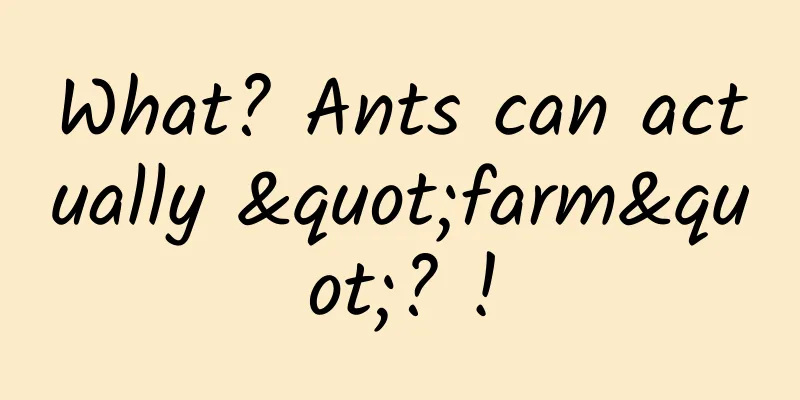What? Ants can actually "farm"? !

|
We all know that many plant seeds are spread by animals. Many woody plants like to use birds to help them spread their seeds. They will use delicious fruits to attract and reward the birds that help them spread their seeds. Birds have strong flying ability and incomplete digestion, which is not very suitable for spreading seeds. However, most of the plants that use birds are woody plants, followed by vines. On the one hand, these plants grow tall, and on the other hand, they have to spend a lot of money to attract birds - after all, it takes a lot of effort to grow delicious fruits. For herbaceous plants, relying on birds to spread seeds is not a good option. But they have a more suitable "tool" for them - ants, and these plants that use ants to spread seeds have a special name - ant-spreading plants. 01 Let ants work willingly This name may be unfamiliar to many friends, who may think that such plants must be very rare. In fact, according to statistics, there are thousands of species of ant-seeded plants in China, and they are distributed in every corner of the country. Since there are so many ant-seeded plants, why do most of us seem to have never seen them? This is probably because they are “small”. Ants are small, and the seeds of plants sown by ants are also very inconspicuous. It turns out that herbaceous plants do not have the luxury of covering their seeds with a thick layer of pulp like woody plants. They only need to use a little favor to get the ants to work for them, such as putting a piece of nutritious "meat" on the seeds, and the ants will happily carry the seeds away. The oil bodies of Viola heterocarpa are very large | Photo provided by the author This "meat" is rich in oil or other nutrients that ants are rich in, and is called "oleosomes". The forms of these oleosomes are varied, and they vary in size. Some are a piece of "white meat" attached to the location where the seeds germinate, some are a thin layer wrapped around the seeds, and a little handle extends outward - making it easy for ants to hold them, and some use very small flesh. Ants will take these ant seeds home, eat the delicious and nutritious parts, or cut them off and share them with their companions. The remaining seeds are thrown out of the nest. Because ants often have fixed garbage dumps, the accumulated food residues and excrement can provide nutrition for these plants. 02 Ants spread plants, using a variety of tricks No matter how rich and varied the types of oil bodies are and how different their appearances are, they all follow two principles: they must serve as food to attract ants and as a handle for ants to hold the seeds. Some oil bodies have a small handle extending from the connection with the seed, so ants can easily bite that piece, such as the seeds of iris. Seeds of Iris parviflora | Photo provided by the author Some oil bodies have a more complex structure, with layers upon layers, which are very suitable for ants to eat, such as the seeds of Epimedium. Epimedium seeds | Photo provided by the author As for seeds that use the flesh, such as the spathiphyllum, their fruit is like a gourd, with one end thick and the other thin, and the small end is designed for ants. This design makes it easier for ants to carry the fruit away. Otherwise, most seeds are smooth, and even if they can be bitten, they are slippery and inconvenient to carry. Fruit of the lily of the valley | Photo provided by the author After looking at so many photos, have you found a bug? Let's continue to imagine the scene: the oleosomes are good grippers, but the ants carry the oleosomes back to the nest. After eating the oleosomes, the smooth seeds without grippers will be left in the nest? In this way, the seeds will not be able to reach the ideal place for growth - the garbage dump of the ants? In fact, different sizes of oleosomes correspond to different ant species. Large ants can carry large seeds, while small ants carry small seeds. In this way, even if the oleosomes are eaten, the size of the seeds is still suitable for the ants' serrated mandibles. Even if they are a little slippery, they can still pick them up and throw them out of the nest. If the small ants barely drag away the large seeds, after eating the oleosomes, they may indeed "have no place to eat" and have to leave the seeds in the nest. Some seeds have a thin waist similar to a gourd, so that the ants are much less stressed when carrying them. 03 What? Seeds can be "transferred"?! Some plants also take "double insurance" measures, borrowing the power of explosion. For ant-seeded plants, if the seeds fall in the same place, they will inevitably be discovered by the same group of ants, sent to the same nest, and thrown into the same garbage dump. Therefore, some ant-seeded plants choose the double insurance mode of ejection + ant-seeking to ensure that the seeds can spread more widely. As the big brother of ant-spreading plants, the huge variety of Corydalis plants have different means of survival. Their fruits are generally of two types. One is long pods, which will split open from the fruit stalk when ripe, dropping seeds to the feet for ants to pick up. The other is shorter but has a bad temper. It also splits open from the fruit stalk, but the peel will turn over in an instant and launch the seeds out. The latter uses the method of catapult to spread seeds. The ejection structure of Corydalis chuandongensis | Photo provided by the author In addition to explosions, the strategy of using wind power to take off into the air has also been cooperated with by ants. For example, the seeds of thistles (actually fruits) have a tuft of hairs similar to those of dandelions (called "pappus") on their heads. With this paraglider, they can fly freely. In theory, with this operation, there is no problem with spreading. However, after landing, they take off their pappus, revealing the small oil bodies inside, and let the ants take them for another ride. This is like taking a plane and then a bus. Cornflowers are very common in our greening, and their seeds are also spread in this way, but their pappus are smaller and their flying ability is relatively ordinary, so their oil bodies are more obvious. Isn't it a waste to have multiple dissemination strategies at the same time? In fact, they are very smart about how to invest. Take the distance of the Corydalis mentioned earlier. The type of Corydalis that "lies flat" waiting for ants to move has particularly large oleosomes, which are more likely to attract ants. However, the Corydalis with the ability to eject is too stingy in its investment in oleosomes. In addition to the plants that we have been talking about before that actively give gifts to ants, there is also a group of plants that passively become "ant-spreading plants." There is a common type of ant around us - harvester ants. The name is very distinctive. Its staple food is plant seeds. They harvest plant seeds as hard as farmers. They are not big, so the seeds they harvest are mostly the size of foxtail grass seeds. Most species in this family have different body sizes. Small worker ants carry and process seeds, while large worker ants have a pair of "big teeth" that can easily bite open the hard shell, crush the seeds, and then hand them over to small worker ants for fine processing. Not all the seeds that are brought back are disposed of immediately, but they are stored in nest chambers close to the ground. The relatively dry environment can prevent germination, but it is inevitable that a rain will cause the seeds to germinate. The germinated seeds absorb oxygen in large gulps to prevent them from being harmed. The worker ants will throw away the germinated seeds, thus helping the plants spread the seeds. The seeds germinate, grow, and produce seeds again. The harvester ants inadvertently become farmers. Most harvester ant genera live in arid and even desert areas, and the closest species to most people is only one species - the needle-haired harvester ant. Needle-haired harvester ant | Photo provided by the author Just taking the harvester ants as an example, the seeds they collect include foxtail grass, quinoa, sorrel and various Umbelliferae, which are common plant species around us. In fact, they all have their own dissemination strategies, either flying or floating on water, but when they fall into the hands of harvester ants, they become "ant broadcasting." Author | Ye Zhengrong Review | Wang Kang Director of Beijing Botanical Garden Science Center Professor-level Senior Engineer This article is produced by the Science Popularization China-Creation Cultivation Program. Please indicate the source when reprinting |
<<: Are you ready to watch the Perseid meteor shower under the big moon?
>>: It is both good and evil, it can be used as food or as poison!
Recommend
The dolphin that swam with its dead cub for more than a month was named Lin
On August 18, 2023, we found a strange Chinese wh...
Are healthy snacks making you fatter? Here are the top ten "confusing snacks"
The weather is getting colder recently. Do you fe...
New user growth strategy: from traffic to retention
Traffic is the most valuable thing on the Interne...
Are iPhone and iOS really safe? New zero-day vulnerability completely puts an end to the "myth"
The Washington Post reported that many people tho...
If I can’t raise Pikachu, can I raise an electric eel?
The animation and games of "Pokémon" ar...
The tenth session of Wolf Uncle's Xiaohongshu hot-selling promotion and drainage training course
Course Outline 1. Basic knowledge: Xiaohongshu’s ...
Why is the top product on the Xiaokaxiu App store so popular (He Jiong, Jiang Xin, Xie Na, Wang Luodan, Li Xiaolu, Jia Nailiang are all playing it)...
Recently, a lip-syncing APP " Xiao Ka Xiu &q...
"Understand operations and do marketing" - three steps to operational strategy
In the early days of mobile Internet , the earlie...
Release the deer back to the mountains! The deer in the wetlands are not just free~
On September 5, we released a male musk deer into...
Great Wall Chery recalls 17,623 electric vehicles, Farasis Energy and others are implicated, CATL denies
According to the information released by the Stat...
How long does it take to produce a new energy heavy truck? "Less than 5 minutes!"
Editor's note: Millions of IPs create science...
The Double Eleven War is about to start. What are the routines and methods of JD.com and Alibaba?
While waiting for the arrival of this year’s Doub...
I'll do 798 too! Toyota Corolla is angry, but domestic brands are happy
After the BYD Qin L with a starting price of 99,8...
How much does it cost to customize a logistics mini program in Anqing?
According to industry insiders, mini programs wil...









